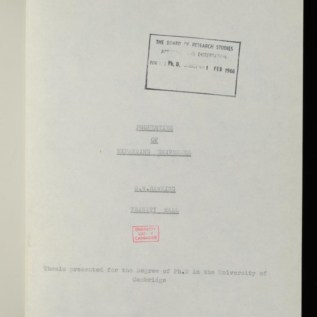By Michael Banks

The PhD thesis of the University of Cambridge physicist Stephen Hawking was made freely available to read this week by the university’s Library’s Office of Scholarly Communication.
Hawking completed his PhD – entitled “Properties of expanding universes” – in 1966 when he was 24 years old. To mark Open Access Week 2017, the 117-page tome was posted on the university’s Apollo open-access repository, which is already home to some 15,000 research articles and 2400 theses.
Yet within hours of Hawking’s opus being posted online, demand was so great that the site crashed. However, according to the university, it was still downloaded more than 60,000 times in the first 24 hours.
“By making my PhD thesis open access, I hope to inspire people around the world to look up at the stars and not down at their feet,” Hawking noted. “Anyone, anywhere in the world should have free, unhindered access to not just my research, but to research of every great and enquiring mind across the spectrum of human understanding.”
Still on famous physicists, how much would you pay for a short note written by Albert Einstein? How about $1.56m? Thought not, but that is how much a letter dubbed his “theory of happiness” fetched at auction in Jerusalem, Israel earlier this week.
Einstein wrote the letter during a lecture tour in Japan in 1922. A bellboy at the hotel he was staying – the Imperial Hotel in Tokyo – delivered a message to the physicist. When Einstein went to tip the boy, he realized he didn’t have any money so instead wrote a note to him on hotel letterhead that read (in German): “A calm and modest life brings more happiness than the pursuit of success combined with constant restlessness.”
The seller – who is unknown – put the letter up for sale at the Winner’s Auctions and Exhibition. While it was only estimated at $5000–8000, the price rocketed after intense bidding. Yet a second note that Einstein wrote at the time on a second sheet of paper with the words “Where there’s a will, there’s a way” sold at the same auction for only $250,000.
Finally, how old is zero? That question has opened up a row between an international group of researchers and the University of Oxford.
Last month the Bodleian Library in Oxford noted that an ancient Indian text, known as the Bakhshali manuscript, had been dated to between 300 and 900 CE.
The manuscript was discovered in 1881 in a field in Bakhshali, near Peshawar in present-day Pakistan, and was acquired by the library in 1902. The document includes arithmetic and was a manual for merchants trading across the Silk Road.
While the library noted that it contained the oldest known written zero but it could not be classed as a “true” zero, as it was only shown as a marker showing an empty decimal place and not as a fully fledged number.
Now a group of historians from Canada, France, Japan, New Zealand and the US, have voiced their disapproval of such a stance. They say that as the historical manuscript contains calculation like long multiplication, it would have been necessary to use zero as a number. They also claim that the document includes statements such as “having added one to zero”. The debate is sure to continue before, er, zeroing in on a solution.



